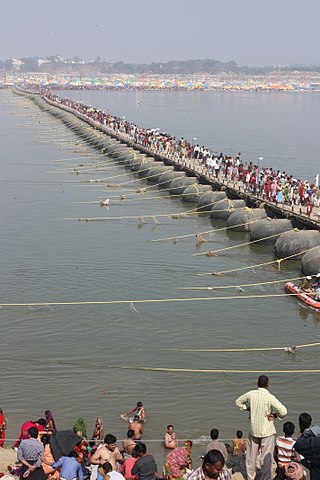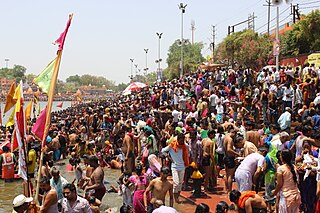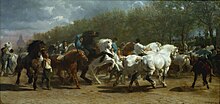
Kumbh Mela or Kumbha Mela is a major pilgrimage and festival in Hinduism, On February 4, 2019, Kumbh Mela witnessed the largest public gathering. It is celebrated in a cycle of approximately 12 years, to celebrate every revolution Brihaspati (Jupiter) completes, at four river-bank pilgrimage sites: Prayagraj, Haridwar (Ganges), Nashik (Godavari), and Ujjain (Shipra). The festival is marked by a ritual dip in the waters, but it is also a celebration of community commerce with numerous fairs, education, religious discourses by saints, mass gatherings of monks, and entertainment. The seekers believe that bathing in these rivers is a means to prāyaścitta for past mistakes, and that it cleanses them of their sins.

Mela is a Sanskrit word meaning "gathering" or "to meet" or a "fair". It is used in the Indian subcontinent for all sizes of gatherings and can be religious, commercial, cultural or sport-related. In rural traditions melas or village fairs were of great importance. This led to their export around the world by South Asian diaspora communities wishing to bring something of that tradition to their new countries.

The International Kolkata Book Fair is a winter fair in Kolkata. It is a unique book fair in the sense of not being a trade fair—the book fair is primarily for the general public rather than whole-sale distributors. It is the world's largest non-trade book fair, Asia's largest book fair and the most attended book fair. It is the world's third-largest annual conglomeration of books after the Frankfurt Book Fair and the London Book Fair. Many Kolkatans consider the book fair an inherent part of Kolkata, and instances of people visiting the fair every day during its duration are not uncommon. The fair offers a typical fairground experience with a book flavour—with picnickers, singer-songwriters, and candy floss vendors. With a total footfall of over 2 million people, it is world's largest book fair by attendance.
Kolkata has many festivals throughout the year. The largest and most magnificently celebrated festival of the city is Durga Puja, and it features colourful pandals, decorative idols of Hindu goddess Durga and her family, lighting decorations and fireworks. Other major festivals are Diwali, Kali Puja, Holi, Saraswati Puja, Poush Parbon, Poila Boishakh, Christmas, Eid al-Fitr, Eid al-Adha, etc.

Yatra, in Indian-origin religions, Hinduism, Buddhism, Jainism and Sikhism, generally means a pilgrimage to holy places such as confluences of sacred rivers, sacred mountains, places associated with Hindu epics such as the Mahabharata and Ramayana, and other sacred pilgrimage sites. Visiting a sacred place is believed by the pilgrim to purify the self and bring one closer to the divine. The journey itself is as important as the destination, and the hardships of travel serve as an act of devotion in themselves.
1954 Kumbh Mela "stampede" was a major crowd crush that occurred on 3 February 1954 at Kumbha Mela in Prayagraj in Uttar Pradesh state in India. It was the main bathing day of Mauni Amavasya, when the incident took place. 4–5 million pilgrims took part in the festival that year, which was also the first Kumbh Mela after India's Independence.

Magh mela, also spelled Magha mela, is an annual festival with fairs held in the month of Magha (January/February) near river banks and sacred tanks near Hindu temples. About every twelve years, Magha melas coincide with what is believed by faithful as an astrologically auspicious position of Jupiter, sun and moon, and these are called the Kumbh Mela such as the one at Allahabad. In the south, a notable festival is at the Mahamaham tank in Kumbhakonam; in the east, at Sagar island of West Bengal and Konark, Puri. The Magha festival, along with the bathing rituals as a form of penance, is also observed by the Hindu community in Bali, Indonesia.
Mass gatherings are events attended by a sufficient number of people to strain the planning and response resources of the host community, state/province, nation, or region where it is being held. Definitions of a mass gathering generally include the following:
Short Cut to Nirvana: Kumbh Mela is a 2004 feature documentary film by Nick Day and Maurizio Benazzo about the 2001 Maha Kumbh Mela at Allahabad. The documentary premiered in the USA on May 11, 2004. The film won several awards on the festival circuit and played in theaters across the US and Europe.
On 10 February 2013, during the Hindu festival of Kumbh Mela, a stampede broke out at the train station in Allahabad, Uttar Pradesh, India, killing 42 people and injuring at least 45 people.

Sirsi Marikamba Temple is a Hindu temple dedicated to Marikamba Devi, located in Sirsi, Karnataka, It is also known as Marigudi, It was built in 1688, Sirsi Shri Marikamba Devi is "elder sister" of all Marikamba Devi's in Karnataka.

Haridwar Kumbh Mela is a mela, associated with Hinduism and held in the city of Haridwar, India held every 12 years. The exact date is determined according to Hindu astrology: the Mela is held when Jupiter is in Aquarius and the Sun enters Aries. The event possesses deep religious significance to Hindus as well as other spiritual seekers. Historically, it was an important commercial event and was attended by merchants from as far as Arabia.

Ujjain Simhastha is a Hindu religious mela held every 12 years in the Ujjain city of Madhya Pradesh, India. The name is also transliterated as Sinhastha or Singhastha. In Hindi, the fair is also called Simhasth or Sinhasth. The name derives from the fact that it is held when the Jupiter is in Leo.

Nashik-Trimbakeshwar Simhastha is a Hindu religious mela held every 12 years in the Nashik district of Maharashtra, India. The name of the festival is also transliterated as Sinhastha or Singhastha. It is one of the four fairs traditionally recognized as Kumbha Melas, and is also known as Nashik-Trimbak Kumbha Mela or Nashik Kumbha Mela.

The Prayag Kumbh Mela, also known as Allahabad Kumbh Mela, is a mela, or religious gathering, associated with Hinduism and held in the city of Prayagraj, India, at the Triveni Sangam, the confluence of the Ganges, the Yamuna, and the mythical Sarasvati river. The festival is marked by a ritual dip in the waters, but it is also a celebration of community commerce with numerous fairs, education, religious discourses by saints, mass feedings of monks or the poor, and entertainment spectacle. Approximately 50 and 30 million people attended the Prayagraj Ardh Kumbh Mela in 2019 and Maha Kumbh Mela in 2013 respectively to bathe in the holy river Ganges, making them the largest peaceful gathering events in the world.

Tirath Singh Rawat is an Indian politician, a sitting Member of Parliament and former Chief Minister of Uttarakhand. He was elected to the 17th Lok Sabha from the Garhwal constituency in the 2019 Indian general election as member of the Bharatiya Janata Party. He was the party chief of Bharatiya Janata Party Uttarakhand from 9 February 2013 to 31 December 2015 and former member of Uttarakhand Legislative Assembly from Chaubattakhal constituency from 2012 to 2017. He was also the first Education Minister of Uttarakhand.

The 2019 Prayagraj Ardh Kumbh Mela was the Ardh Kumbh Mela held at Triveni Sangam in Prayagraj, Uttar Pradesh, India from 15 January to 4 March 2019.

The Sibi Mela is an annual cultural show held in Sibi, in the Balochistan Province of Pakistan. The first Sibi Mela was held in Sibi in January 1885. It has subsequently developed into a cultural festival, with animal markets, camel racing, tent pegging and exhibitions of handicrafts, tribal dresses and folk dances.

2016 Mahamaham is a recurring festival most recently celebrated at Kumbakonam in Thanjavur district of Tamil Nadu, India from 13 February 2016 to 22 February 2016. Mahamaham, also known as Mahamagham or Mamangam, is a Hindu festival celebrated every 12 years in the Mahamaham tank in Kumbakonam.


















